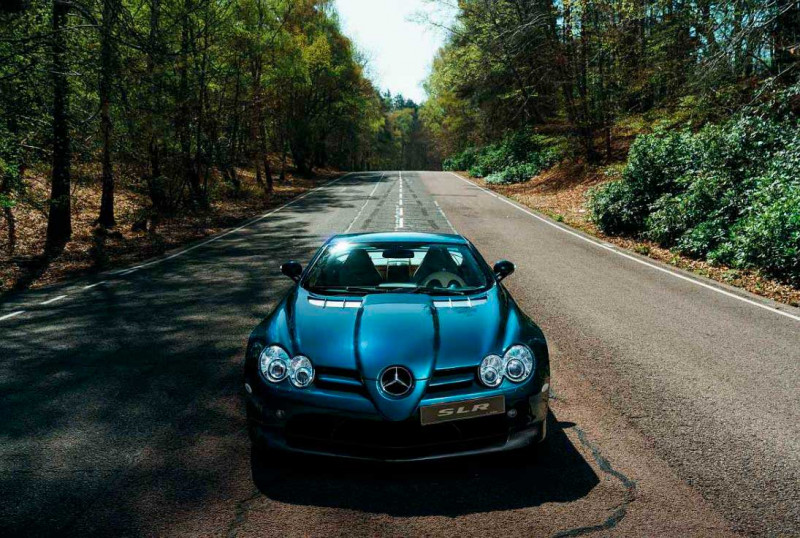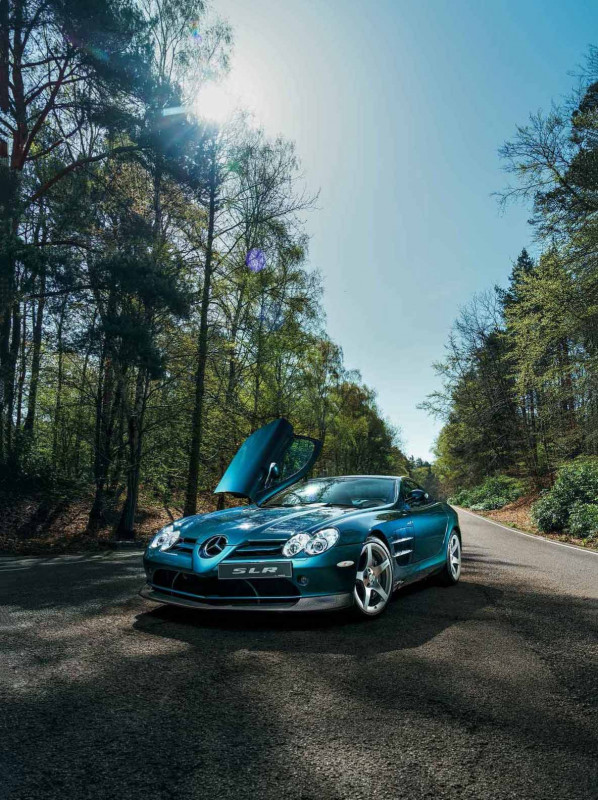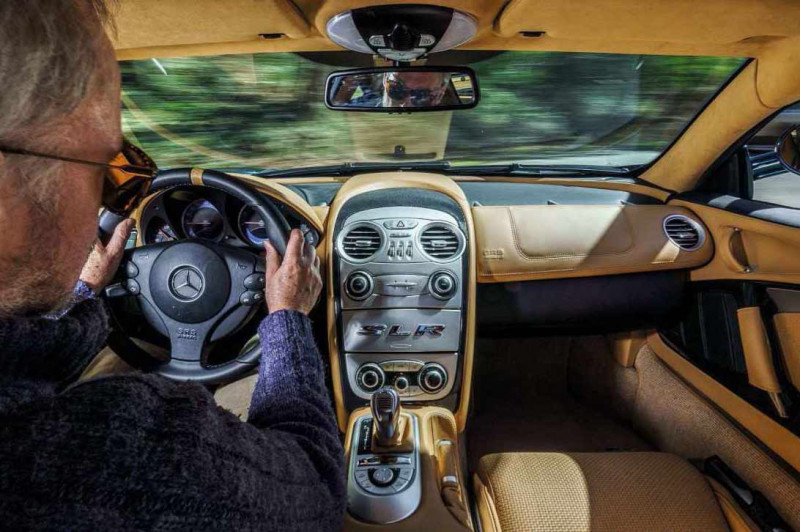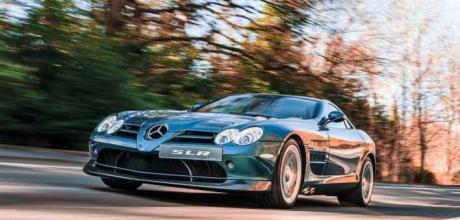630bhp 2003/2021 Mercedes-Benz SLR McLaren by MSO C199
The Mercedes-Benz SLR McLaren was always a bit of a brute, but a new version from McLaren Special Operations aims to civilise it. Mark Dixon tries the SLR that’s been to finishing school Photography Dean Smith
RETURN OF THE MAC MERCEDES SLR McLAREN by MSO
The original split opinion, so McLaren had a rethink – and let Drives Today loose in the result
Woking’s skunk works reinvents the brutal Mercedes SLR McLaren PLUS the legendary 722 GT racer
I’m kicking myself. The boys from McLaren Special Operations have just rocked up to the test track in a sun-bleached So-Cal VW ‘Squareback’ – the VW Variant, to us Brits – and I’m looking distinctly underdressed in my plain-Jane Volvo estate. If only I’d brought the Mustang instead.

I should have expected this. As we discovered when we ran a feature on McLaren employees and their classic cars in Drives Today, these people are proper petrolheads, doing jobs that mean more than just paying the bills. Today, gathered at a Surrey test track we have three key members from the skunk works that is MSO, based in an anonymous industrial unit a few miles away from McLaren’s spectacular Technology Centre: MSO heritage manager Tom Reinhold, workshop manager Merrill Burton and senior SLR technician Matt Brown.
‘THE ENGINE IS REDLINED AT 7000RPM BUT YOU’LL NEVER NEED TO GET NEAR THAT FIGURE’
All three of these guys are proper car enthusiasts. The Squareback is Merrill’s; Matt has a Focus ST170-equipped Mk1 Escort track car, and Tom a 1927 Austin Seven Ulster. More significantly, both Merrill and Matt worked on the original C199 / W199 Mercedes SLR McLaren from its earliest development phases and have been with MSO since its inception. ‘I recruited Matt during a surfing holiday,’ recalls Merrill with a grin.

This band of brothers is the core team behind the car we’re about to drive. Dubbed ‘SLR by MSO’, it’s a heavily reworked version of the 2003-2009 supercar that was somewhat Marmite in its appeal. Have MSO’s tweaks rendered it any more palatable?
Back in the day, the SLR seemed something of an oddball. Technologically impressive, of course, but curiously un-McLaren like in its weight and bulk. Just over a decade earlier, the company had unveiled what to many is still the greatest road car of all time: the F1. It was hugely powerful yet astonishingly light: a driver-focused car with few – if any – compromises.
The Mercedes-Benz SLR McLaren, as it was officially known, was a different kettle of Fisch. Gordon Murray was the genius behind it but the car was very much not his idea and he didn’t like it much at the time. He recently explained why in a Collecting Cars podcast with Chris Harris.
THE SLR ENDED UP NOT KNOWING WHAT IT WANTED TO BE. IT HAD AN IDENTITY CRISIS’ GORDON MURRAY
‘[After] BMW were so chuffed with the publicity they got with the F1, I started working on Project Two: a small car, supposed to be built in units of 1000pa and much more affordable. Then Ron Dennis announced – this would have been 1997, 1998 – that he’d just signed a five-year contract with Mercedes-Benz for Formula 1 engines…

‘We flew to BMW for [Wolfgang] Reitzle to come down and tell us we’d got the deal. All the way over in the plane, Ron was saying “You’re an engineer, you don’t understand, they’ll be fine,” and I went “Ron, you really have no idea how much they hate each other!” So we went into the office, Reitzle came in and said “I’ve got some great news”, to which Ron replied “Before you say anything, I just need to tell you what we’ve done…” At which Reitzle just said “Goodbye, Mr Dennis”, turned on his heels and left.
‘I then had to dream up something to keep us going. We did a little two-seater sports car with a Mercedes V8, actually a really sexy little car, and sent it to them; heard nothing for three months, and then they came back to us with: “The bad news is that we’re not going to produce your car; the good news, we’ve got a job for you because we’ve just done the Vision SLR show car and we want to produce it. You get to do everything: engineer it, make it, test it, homologate it.” And that was the beginning of the SLR.’
Murray goes on to say that he’s still very proud of the car’s structure and the way it was built. ‘It had a robot bonded carbon tub… it broke new ground everywhere.
Unfortunately, it had committees and levels of management, and ended up not knowing what it wanted to be. We didn’t do the styling and it had an identity crisis.’
Drive’s then-editor David Lillywhite got his hands on a production SLR in 2004 but didn’t find himself unconditionally loving it either. ‘From the start, the SLR McLaren was saddled with something it couldn’t live up to,’ he wrote in issue 17. ‘But as a high-performance road car, I hoped it would still shine; I imagined that it would feel like an über-powered AMG SL, as sophisticated as it is powerful.
‘THE V8 DELIVERED 626BHP AND 575LB FT WITH A TERRIFYING BELLOW FROM SIDE-EXIT EXHAUSTS’
But it didn’t. Why not? Because this bloody thing’s a brute. It’s billed as a supercar but it’s more of a super-muscle-car, a modern-day Cobra that you hitch a wild ride on, if you dare.’ Unlike any Cobra, the SLR was at least technologically sophisticated. It featured a carbonfibre tub, carbon-ceramic brake discs, a five-speed automatic gearbox with manual option (on early cars, rather confusingly operated by buttons behind the steering wheel spokes), and every technological aid known to man: ESP, EBD, ABS and Brake Assist among them. And then, of course, there was the epic Mercedes V8.
Dry-sumped and supercharged, it produced 626bhp and 575lb ft from its 5.4 litres, which it delivered with a terrifying bellow from side-exit exhausts. The SLR could comfortably breach 200mph; Drives Today contributor and hugely experienced road tester John Simister, who drove a prototype SLR in 2003, reported that it was the fastest he’d ever been in a car.
In a way, this incredible performance allied with state of- the-art technology was both very Mercedes and very McLaren. But it was also rather unsubtle, which is why McLaren Special Operations has got involved. The cars are no strangers to MSO; with some 2157 built, Tom Reinhold reckons there’s been one in the workshop ever since MSO was set-up in 2010. And the SLR by MSO is far from the first variation that McLaren has offered. In chronological order, since the original Coupé was launched we’ve seen the 722 Edition (2004), the Roadster (2007), 722 GT (2007 – and separately profiled after this feature), Roadster 722 S (2009, with no roof), the speedster-style Stirling Moss Edition (2009), and in 2010 the McLaren Edition. Phew.
‘That was the very first MSO project,’ explains Merrill Burton about the last-named. ‘We did it when we were setting up MSO in 2010-2011, at the end of SLR production.’ Tom Reinhold adds: ‘It was very much under the radar and only 25 cars were built. Typically, a customer would be in the workshop to see their F1 being serviced, notice the SLR on the ramp and ask “What’s that?” Once we told them about the new bodywork, suspension, downforce, steering and so on, they would sign up there and then.
‘In the last few years people have been saying they liked The McLaren Edition but they wanted something a bit more understated. The 2010 Edition was more track-focused, more sporting; this car goes back to the original brief and enhances the GT element.’
So what do you get for the £121,500 plus VAT – plus donor vehicle – that MSO will request in exchange? Well, for a start, you get something that looks fabulous. Naturally, customers can specify any colour that they want, and MSO itself chose this particular shade of metallic green for its demo car (which is based on a pre-production SLR, so something of a historic vehicle in its own right). It looks simply perfect, which is just as well since the new paintjob accounts for £42,000 plus VAT all by itself. Tick all the options and you could be spending £176,000. Plus VAT…
The interior is, if anything, even more impressive. MSO has completely retrimmed it in a way that cleverly references Mercedes of the 1950s and ’60s. The seats have leather-and string basket-weave inserts, which are also replicated in the door cards, while the carpets are of a box-weave style that harks back to the days of Moss, Jenks and ‘that’ Mille Miglia victory. ‘We’ve trimmed this car in matching shades but you can have any combination of colours,’ says Tom. ‘We’ve also modified the seat design with new foams for greater comfort.’
The wheels are unique, too. ‘The car was designed on five-spoke 18in alloys, which were standard-spec, but most customers opted for the 19in “Turbine” style,’ Tomadds. ‘So we decided to revive the original look but in the larger size. Each of the new wheels is also 2kg lighter than the Turbines.’
These aesthetic modifications are just the icing on a very thoroughly baked cake. Taking the McLaren Edition as its baseline, MSO has further refined the dynamics in several key departments: suspension, steering and aerodynamics. Amazingly, MSO has managed to significantly improve on the last of these by designing a revised front spoiler and rear diffuser, and by lowering the suspension 10mm. Together, these mods produce similar downforce to an SLR 722’s yet with a reduction in overall drag.
Spring rates and dampers have also been tuned – the latter are passive, not active – and the steering has been tweaked to give a more linear response by incorporating an additional universal joint in the column, and a revised power-steering pump. But perhaps most impressive is the work done to the exhaust system, always a tricky element due to Gordon Murray’s insistence that it be made to exit ahead of the doors. Somehow, MSO has shaved 30kg off the original, and there’s now an option to have a switchable cut-out, to release the full thunder of that V8. The revised exhaust, plus a sports air filter, help release a few extra bhp, too.
Enough of the technical stuff. What’s it like to drive? We’ve brought the SLR to Longcross test track, just off the M3 near Chobham in Surrey, partly because it’s convenient to McLaren and MSO, but also because McLaren used this facility extensively when developing the F1 and for shakedown tests with the SLR. The second fact was, of course, not unrelated to the first.
The wide sill and low-set steering wheel make entry a slightly intricate performance if you’re on the well-built side, and the scissor door needs a good tug to pull down and close. The interior is not cramped but it does wrap around you pretty snugly. Nevertheless, MSO’s trim changes have made it a lovely place to spend time in; only the bright aluminium finisher on the centre console (which looks suspiciously like painted plastic) seems curiously dated. I think I’d be asking MSO to anodise that on my commission. Also something of a throwback is the way you start the engine by first turning a key and then flipping up the top of the gearknob and pressing an ‘engine start’ button – remember when those were considered super-cool? But otherwise the controls are relatively simple, with conventional rotary dials for adjusting heating and air-con, and another pair of dials for (on the left) selecting Auto, Manual or Sport gearbox mode, and (to the right) for choosing between three levels of shift speed. There’s a button, too, to activate the open-exhaust option. And, since we’re on a test track, it would be rude not to, wouldn’t it? The noise released when you push the engine-start button is just incredible. The V8 erupts into a meaty grumble that’s more NASCAR than Nürburgring, resounding off the nearby trees with a bassy thunder. Leave the gear selector in Auto and rumble away onto the track, letting the engine’s massive torque do the work; it’s redlined at 7000rpm but, honestly, you’re never going to need to get near that figure, you’ll only be doing it because you want to hear what a supercharged 630bhp V8 sounds like at full chat.
While the engine warms through as we gently lap the circuit – Matt Brown is riding shotgun with me to start with – there’s time to think about the ride quality and steering. Yes, we’re on a test track, but the surface isn’t brilliant (one of the reasons why McLaren no longer uses Longcross much, the other being that most of the site has been given over to movie production – we’re getting fragmentary glimpses of the latest Marvel blockbuster on the infield) and yet the SLR is coping well with the concrete and tarmac’s irregularities. The suspension is not harsh or crashy, and even at low speeds its secondary ride (the way it deals with minor jiggles) is impressive.
Paradoxically, when I mention this to Matt, he replies: ‘The springs are slightly harder and the damper rates are different, plus of course the car now rides 10mm lower. Being quite large and heavy, the standard car had a slight tendency to pitch and dive, to roll and lean, and we’ve tried to maximise its potential, to give it a more sporty feel.’
Test tracks and public roads are very different environments, and Drives Today regular Harry Metcalfe, who spent three days living with this very car for his Harry’s Garage YouTube channel, reckons the ride out in the wider world is a little compromised if you’re enjoying it as a GT – although he admits that the car felt exceptionally planted over the switchbacks of a moorland road. His video is well worth a watch, not least to experience the gut-stirring braaaap of the V8 as it passes the camera; phones and laptops do come in handy for aural satisfaction.
You can’t fault the steering, which is nicely weighted and linear in feel – and there’s a little tell-tale at the top of the rim, in basket-weave trim that matches the seats. The car turns-in beautifully and it’s clear there’s plenty of grip on today’s dry surface, but Matt (who, like Merrill, has worked with these cars since their pre-launch testing days in 2002) cautions that you can never afford to let your attention slip. Gordon Murray went to great lengths to optimise weight distribution – literally, since he moved the engine right back in the nose, beyond even the front axle line, and there’s four feet of straight-line induction chamber as a result – which resulted in a 49:51 front:rear split, but there’s still an awful lot of power and torque being sent to two wheels.
Fortunately, the V8 delivers its power progressively, in best supercharged fashion. As you head towards that 7000rpm redline, the whine of the supercharger, the thrash of valvetrain and the rush of induction noise start to compete with the rising snarl of the exhaust; it’s addictive stuff, like being in a really, really well-sorted US muscle car. And speaking of being well-sorted, it’s worth remembering that MSO’s demonstrator was originally a development hack, so the 50,000-odd miles that it has covered will have been exceptionally hard-driven – yet, despite that, there is not a trace of a creak or rattle from anywhere, ever.
The gearbox is positively old skool, being a torque-convertor automatic with a mere five speeds, and changes happen relatively slowly no matter how you set the dial on the console. But you know what – it doesn’t matter. The auto ’box suits the massive torque of the engine and the gear you happen to be in is almost irrelevant; press the throttle at ludicrously low revs and the car responds instantly. If anything takes getting used to – aside from the ballistic acceleration – it’s the brakes, which are tricky to modulate.
There’s a slight but perceptible roll-over action to the floor hinged pedal before you can feel the pads bite. The fact that the system is brake-by-wire, in which electronic sensors measure foot input and allocate pad pressure accordingly from an electrically driven hydraulic pump, doesn’t help – but they’re certainly a lot less tricky than they were on the original SLR back in 2003. Brake hard, and an airbrake pops up just like on the 1955 Mercedes-Benz Le Mans cars, too.
That airbrake, the intoxicating noise from the side-exit exhausts, the ’50s-style vents in the front wings and their bright-metal side-strakes – there’s a lot of theatre to the SLR. But when you’re not in the mood, you can also mute the sturm und drang by switching out the exhaust, then drift along on a whiff of throttle and relax into a long journey. Even Gordon Murray now admits that he admires the SLR’s abilities as, quote, a ‘continent crusher’, and I’d like to think he’d appreciate the further refinements that MSO has wrought on his creation.
Is it the perfect GT? No. Some of the C199 SLR’s foibles are simply incurable, in particular its bloated width and its massive proboscis, which can lead to anxiety when edging out of junctions or cresting a sharp brow. But the aesthetic upgrades have suddenly made it feel much classier and less ostentatious, while the dynamics are a big improvement on what was on offer in 2003. And, dear God, the noise! This car has genuine character as an analogue machine in an increasingly digital world. It may have taken the best part of two decades to mature, but the SLR finally seems to have come of age.
This page Gordon Murray disclaims responsibility for the SLR’s looks, and is not hugely fond of it – but he admires the car’s ability to cover vast distances with ease. Clockwise from right Side-exit exhausts were a technological challenge; engine is set fully behind front axle; mobile phone for summoning help in case of breakdown; engine start button in gear selector; silver-painted insert in console has not aged well.
‘MSO HAS RETRIMMED THE INTERIOR IN A WAY THAT REFERENCES MERCEDES OF THE 1950s AND ’60s’
2003/2021 Mercedes-Benz SLR McLaren by MSO C199
- Engine 5439cc 24-valve V8, DOHC per bank, screw-type supercharger, fuel injected
- Max Power 630bhp @ 6500rpm
- Max Torque 575lb ft @ 4000rpm
- Transmission Five-speed automatic, rear-wheel drive
- Steering Power-assisted rack-and-pinion
- Suspension Front and rear: double wishbones, coil springs, telescopic dampers. Front anti-roll bar
- Brakes Carbon-ceramic discs
- Weight c1750kg
- Top speed c210mph
- 0-60mph c3.4sec
This page and left Scissor doors, shark-like gills in the front wings and prominent side strakes are all part of the SLR’s theatre.



The word ‘retromod’ doesn’t really seem to cut it when the car you are updating is barely old enough to qualify for classic insurance. (Of course, the word retromod is horrible and shouldn’t be used anyway, but that’s another story.) Yet news that McLaren is doing a number on the McMerc (alright, the Mercedes-Benz SLR McLaren) seems to really tap into the zeitgeist.
Even before Octane heard the news and Mark Dixon tested the sensational results, we had been discussing that this mightily impressive machine seemed to be one of those rare greats that slips under the radar. Not like the Jaguar XJ220, which even now tracks way below its contemporary rivals, all of which have taken off, even the Bugatti EB110 – but more like the XJR15, which languished in the doldrums for so long before savvy (and wealthy) petrolheads realised that, by reverse-engineering these Jaguar race-cars-for-the-road, you could have the next best thing to a McLaren F1 for a tiny fraction of the price.
All of which makes mention in our second McMerc piece – James Page’s superb analysis of the 722 GT – of a potential renaissance all the more tantalising. And to my mind probably brings that XJR15 comparison into even sharper relief. McLaren is pretty tight-lipped about the ‘project’ just at the moment, but we are justifiably excited. Bring it on!
We all deserve a second chance I may not have always owned one, but I like to think I have always been a Lotus man. I suppose I can’t count my Westfield Eleven, but Elan, Elan +2, Elite and Elise have all been wonderful additions to the Elliott fleet over the years. And as soon as the kids are gone, or a pension matures, or the right Lotto numbers come up, I can promise there will be another.
Being a diehard Lotus fan can be testing, though. At times it has been rather like being a devoted England football fan – the talent is there for all to see, but somehowit is perpetually squandered until inevitable failure ensues. Not now, though. When Geely took over in 2017, I was shocked by the open distrust of the new owners, an overarching suspicion straight out of some 1950s movie. Yet look at what Geely has done at Volvo and what it is now promising to do at Lotus. Stability and investment? Lotus has never had it so good.